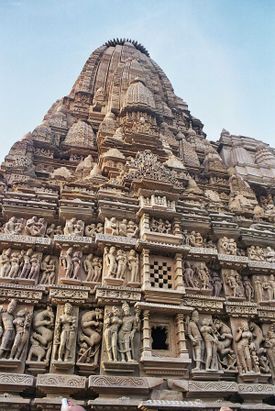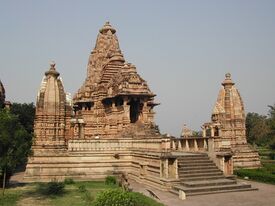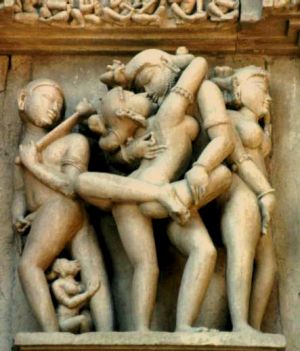Khajuraho Group of Monuments: Difference between revisions
meta>Rickyrab |
meta>Rickyrab (→The statues and carvings of Khajuraho: more encyclopedic) |
||
| Line 59: | Line 59: | ||
==The statues and carvings of Khajuraho== | ==The statues and carvings of Khajuraho== | ||
Khajuraho temples do not contain sexual themes inside the premises of the Temple or near the deity; however, they contain such themes on external carvings. According to current Hindu interpretations, they portray that, for seeing the deity, one must leave his or her sexual desires outside the Temple. They also show that the inner divinity of the Temple is pure like the soul (atman), which is unaffected by sexual desires and other gross tendencies of the physical body, such as destiny, whereas the external curvature and carvings of the Temples depict the bodily changes that occur in us. Only 10% of the carvings contain sexual themes; those do not show deities, they show sexual activities between ordinary humans. The rest depict the everyday life of the common Indian of the time when the carvings were made. For example, those depictions show ladies applying makeup, musicians, potters, farmers, and other folks. Those mundane scenes are all away from Temple deities. A famous misconception is that since the old structures with carvings in Khajuraho are Temples, the carvings depict sex between deities. In Khajuraho Temples, the idols of Shiva, Nandi, Goddess Durga, Incarnations of Vishnu etc are clad in [[modesty|modest]] clothing. <ref>[http://www.hindujagruti.org/news/article/denigrations/articles/the-facts-of-khajuraho.html The Facts of Khajuraho and Images of Carvings] -- Accessed on March 06, 2007</ref> | |||
The Chandela rulers between 950-1050 built these temples. They followed the tantric cult, which believes that gratification of Earthly desires is a step towards attaining the infinite liberation, Nirvana. In ancient days, when boys lived in hermitages, following ''[[brahmacharitva]]'' until they attained manhood, the only way they could prepare themselves for the worldly role of 'householder' was through the study of these sculptures and the earthly passions they depicted. <ref>[http://www.cultureholidays.com/Temples/khajuraho.htm Article on Khajuraho Temples] -- Accessed on March 06, 2007</ref> | |||
==References== | ==References== | ||
Revision as of 20:12, 7 March 2007
Template:Infobox Indian urban area
| UNESCO World Heritage Site | |
|---|---|
 | |
| Criteria | Cultural: i, iii |
| Reference | 240 |
| Inscription | 1986 (10th session) |
Khajuraho (Hindi खजुराहो) is a village in the Indian state of Madhya Pradesh, located in Chhatarpur District, about 385 miles (620 kilometres) southeast of Delhi, the capital city of India.
One of the most popular tourist destinations in India, Khajuraho has the largest group of medieval Hindu temples, famous for their erotic sculpture. The name Khajuraho is derived from the Hindi word khajur meaning date palm.
The city was once the original capital of the Chandela Rajputs, a Hindu dynasty that ruled this part of India from the 10th to the 12th centuries. The Khajuraho temples were built over a span of a hundred years, from 950 to 1050. The Chandela capital was moved to Mahoba after this time, but Khajuraho coninued to flourish for some time.
The whole area was enclosed by a wall with eight gates, each flanked by two golden palm trees. There were originally over 80 Hindu temples, of which only 22 now stand in a reasonable state of preservation, scattered over an area of about 8 square miles (21 km²).
Unlike other cultural centers of North India, the temples of Khajuraho never underwent massive destruction and a number of them have survived. They are fine examples of Indian architectural styles that have gained popularity due to their salacious depiction of the traditional way of life during medieval times. They were rediscovered during the late 19th century and the jungles had taken a toll on some of the monuments.
The Khajuraho group of monuments has been listed as a UNESCO World Heritage Site.
Architecture
Khajuraho temples, constructed with spiral superstructures, adhere to northern Indian shikhara temple style and often to a Panchayatana plan or layout. A few of the temples are dedicated to the Jain pantheon and the rest to Hindu deities - to God's Trio, Brahma, Vishnu and Shiva, and various Devi forms, such as the Devi Jagadambi temple. A Panchayatana temple had four subordinate shrines on four corners and the main shrine in the center of the podium, which comprises their base. The temples are grouped into three geographical divisions : western, eastern and southern
With a graded rise secondary shikharas (spires) cluster to create appropriate base for the main shikhara over the sanctum. Kandariya Mahadeva, one of the most accomplished temples of the Western group, comprises eighty-four shikharas, the main being 116 feet from the ground level.

These shikharas - subordinate and main, attribute to the Khajuraho temples their unique splendor and special character. With a graded rise of these shikharas from over the ardhamandapa, porch, to mandapa, assembly hall, mahamandapa, principal assembly hall, antarala, vestibule, and garbhagraha, sanctum sanctorum, Khajuraho temples attain the form and glory of gradually rising Himalayan peaks.These temples of khajuraho have sculptures that look very realistic and are studied even today.
Landscape
The Khajuraho temples are now set in a parkland landscape. When India gained independence from Britain in 1947 the landscape setting was semi-desert and scrub. The archaeological park now has something of the character of an English public park, with mown grass, rose beds and ornamental trees. This may be popular with visitors but has no relationship with the historic landscape at the time the temples were built. The development of landscape archaeology as an academic discipline raises questions concerning the landscape of archaeology of Khajuraho and the original relationship between the temple complex and the surrounding area. There are no records of what the original landscape might have been but it is known that a large community of priests used the temple complex and that Indian gardens in the tenth century were predominantly tree gardens. They did not have lawns or herbaceous flowering plants.

The statues and carvings of Khajuraho
Khajuraho temples do not contain sexual themes inside the premises of the Temple or near the deity; however, they contain such themes on external carvings. According to current Hindu interpretations, they portray that, for seeing the deity, one must leave his or her sexual desires outside the Temple. They also show that the inner divinity of the Temple is pure like the soul (atman), which is unaffected by sexual desires and other gross tendencies of the physical body, such as destiny, whereas the external curvature and carvings of the Temples depict the bodily changes that occur in us. Only 10% of the carvings contain sexual themes; those do not show deities, they show sexual activities between ordinary humans. The rest depict the everyday life of the common Indian of the time when the carvings were made. For example, those depictions show ladies applying makeup, musicians, potters, farmers, and other folks. Those mundane scenes are all away from Temple deities. A famous misconception is that since the old structures with carvings in Khajuraho are Temples, the carvings depict sex between deities. In Khajuraho Temples, the idols of Shiva, Nandi, Goddess Durga, Incarnations of Vishnu etc are clad in modest clothing. [1]
The Chandela rulers between 950-1050 built these temples. They followed the tantric cult, which believes that gratification of Earthly desires is a step towards attaining the infinite liberation, Nirvana. In ancient days, when boys lived in hermitages, following brahmacharitva until they attained manhood, the only way they could prepare themselves for the worldly role of 'householder' was through the study of these sculptures and the earthly passions they depicted. [2]
References
- ↑ The Facts of Khajuraho and Images of Carvings -- Accessed on March 06, 2007
- ↑ Article on Khajuraho Temples -- Accessed on March 06, 2007
See also
External links
- Detail Information on Khajuraho
- Temples of Love Khajuraho with Gallery
- Photos of Khajuraho temples
- Photos of Khajuraho
- Love, The Living Spirit of Khajuraho by Prof. P. C. Jain and Dr. Daljeet.
- Photos and travel tips for Khajuraho temples including maps showing how to get there
- Lessons from Khajuraho
- Template:Wikitravel
bpy:খাজুরাহ de:Khajuraho es:Khajuraho fr:Khajurâho hi:खजुराहो kn:ಖಜುರಾಹೊ nl:Khajuraho ja:カジュラーホー pl:Khadżuraho pt:Khajuraho ru:Хаджурахо sv:Khajuraho
